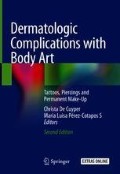Abstract
All body-modifying methods can lead to complications depending on the conditions in which the procedures are performed, on the training and the skills of the practitioner, on the materials used, and on the aftercare. Poor hygienic standards can result in localized infections but can also lead to severe life-threatening conditions or even result in irreversible damage. Body art practitioners should be informed about good hygienic practice and should be aware of the complications that can arise from these procedures. In this chapter the requirements for a hygienic working environment and equipment and the management of a tattoo parlor including the sterilization process and waste disposal will be addressed. The procedure of tattooing will be explained step by step including preventive measures such as adequate hand hygiene and instructions for good aftercare. The customer has to be informed about the risks of the procedure but also has the responsibility to inform the practitioner about his health condition. Client suitability and knowledge of contraindications are important aspects that are often neglected.
Access this chapter
Tax calculation will be finalised at checkout
Purchases are for personal use only
References
Dieckmann R, Boone I, Brockmann SO et al (2016) The risk of bacterial infection after tattooing. Dtsch Arztebl Int 113(40):665–671. https://doi.org/10.3238/arztebl.2016.0665
Wollina U (2012) Severe adverse events related to tattooing: a retrospective analysis of 11 years. Indian J Dermatol 57:439. https://doi.org/10.4103/0019-5154.103062
Kazandjieva J, Tsankow N (2007) Tattoos: dermatological complications. Clin Dermatol 25:375–382
Handrick W, Nenoff P, Müller H et al (2003) Infections caused by piercing and tattoos – a review. Wien Med Wochenschr 153:194–197
Resolution ResAP(2008)1 on requirements and criteria for the safety of tattoos and permanent make-up (superseding Resolution ResAP(2003)2 on tattoos and permanent make-up). https://search.coe.int/cm/Pages/result_details.aspx?ObjectID=09000016805d3dc
Piccinini P et al (2016) Safety of tattoos and permanent make-up: final report JRC Report, EUR 27947 EN. https://ec.europa.eu/jrc/en/publication/eur-scientific-and-technical-research-reports/safety-tattoos-and-permanent-make-final-report
Moniteur Belge - Arrêté royal réglementant les tatouages et les piercings AR de 25 novembre 2005. Accessed 16 Oct 2017
www.veiligtatoeerenenpiercen.nl. Accessed 16 Oct 2017
Veenstra T (2015) The Amsterdam model for control of tattoo parlours and businesses. In: Serup J, Kluger N, Bäumler W (eds) Tattooed skin and health. Current problems in dermatology, vol 48. Karger, Basel, pp 218–222
Schmidt A (2015) Hygiene standards for tattooists. In: Serup J, Kluger N, Bäumler W (eds) Tattooed skin and health. Current problems in dermatology, vol 48. Karger, Basel, pp 223–227
http://www.socialstyrelsen.se. Accessed 16 Oct 2017
Bergström J, Bodlund M (2015) Hygiene standards in the tattoo parlor and practices for prevention of infection. In: Serup J, Kluger N, Bäumler W (eds) Tattooed skin and health. Current problems in dermatology, vol 48. Karger, Basel, pp 228–235
Kluger N, De Cuyper C (2017) A practical guide about tattooing for patients with chronic skin disorders and other medical conditions. Am J Clin Dermatol. https://doi.org/10.1007/s40257-017-0326-5
Goldstein N (2007) Tattoos defined. Clin Dermatol 25:417–420
Rush JA (2005) Spiritual tattoo. A cultural history of tattooing, piercing, scarification, branding and implants. Frog Ltd, Berkeley. ISBN 978-1-58394-117-7.
Scheinfeld N (2007) Tattoos and religion. Clin Dermatol 25:362–366
Sperry K (1991) Tattoos and tattooing. Part I: history and methodology. Am J Pathol Forensic Med 12(4):313–319
Kierstein L, Kjelskau KC (2015) Tattoos as art, the drivers behind fascination and the decision to become tattooed. In: Serup J, Kluger N, Bäumler W (eds) Tattooed skin and health. Current problems in dermatology, vol 48. Karger, Basel, pp 37–40
Liszewski W, Jagdeo J, Laumann A (2016) The need for greater regulation, guidelines and a consensus statement for tattoo aftercare. JAMA Dermatol 152(2):141–142
Larousse Médical illustré (1925) Librairie Larousse Paris 1994-5
Rosenkilde F (2015) Tattoo machines, needles and utilities. In: Serup J, Kluger N, Bäumler W (eds) Tattooed skin and health. Current problems in dermatology, vol 48. Karger, Basel, pp 21–30
Kristensen L (2015) The technique and craftsmanship of tattooing in the professional tattoo parlor. In: Serup J, Kluger N, Bäumler W (eds) Tattooed skin and health. Current problems in dermatology, vol 48. Karger, Basel, pp 31–36
http://who.int/gpsc/5may/Hand_Hygiene_Why_How_and_When_Brochure.pdf
Laux P et al (2016) A medical-toxicological view of tattooing. Lancet 387(10016):395–402
Kluger N (2012) Can a mother get a tattoo during pregnancy or while breastfeeding? Eur J Obstet Gynecol Reprod Biol 16:234–235
Khan IU, Moiemen NS, Firth J (1999) Malignant melanoma disguised by a tattoo. Br J Plast Surg 52:598
Kluger N, Catala D, Thibaut I (2008) Naevus and tattooing: a matter of concern. J Eur Acad Dermatol Venereol 22:767–768
Kluger N, Estève E, Set al F (2017) Tattooing and psoriasis: a case series and review of the literature. Int J Dermatol 56:822–827
Breuner CC, Levine DA, Committee on Adolescence (2017) Adolescent and young adult tattooing, piercing, and scarification. Pediatrics. https://doi.org/10.1542/peds.2017-1962
Acknowledgment
-
Liz Kierstein, Tatto-Liz Copenhagen, Denmark
-
Jens Bergström, Tattoo and Piercing Education Scandinavia, Sweden
-
Davy D’hollander, Tek Tik Antwerpen, Belgium
-
Sandy Verfaille, Inksane Roeselare, Belgium
Author information
Authors and Affiliations
Editor information
Editors and Affiliations
3.1 Electronic Supplementary Material
Video 3.1
Tattooing procedure by Sandy Verfaille, Inksane, Belgium, recording Dr. De Cuyper (MP4 252525 kb)
Rights and permissions
Copyright information
© 2018 Springer International Publishing AG, part of Springer Nature
About this chapter
Cite this chapter
De Cuyper, C. (2018). Procedure of Tattooing. In: De Cuyper, C., Pérez-Cotapos S, M. (eds) Dermatologic Complications with Body Art. Springer, Cham. https://doi.org/10.1007/978-3-319-77098-7_3
Download citation
DOI: https://doi.org/10.1007/978-3-319-77098-7_3
Published:
Publisher Name: Springer, Cham
Print ISBN: 978-3-319-77097-0
Online ISBN: 978-3-319-77098-7
eBook Packages: MedicineMedicine (R0)

